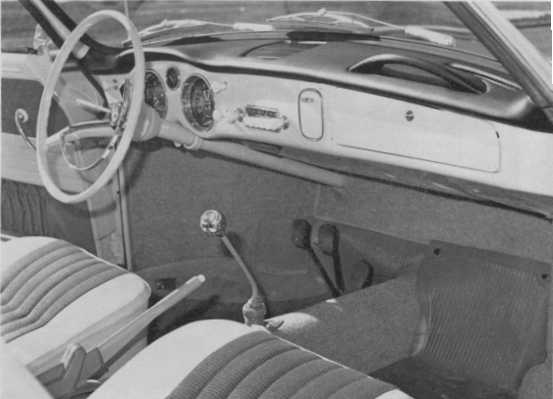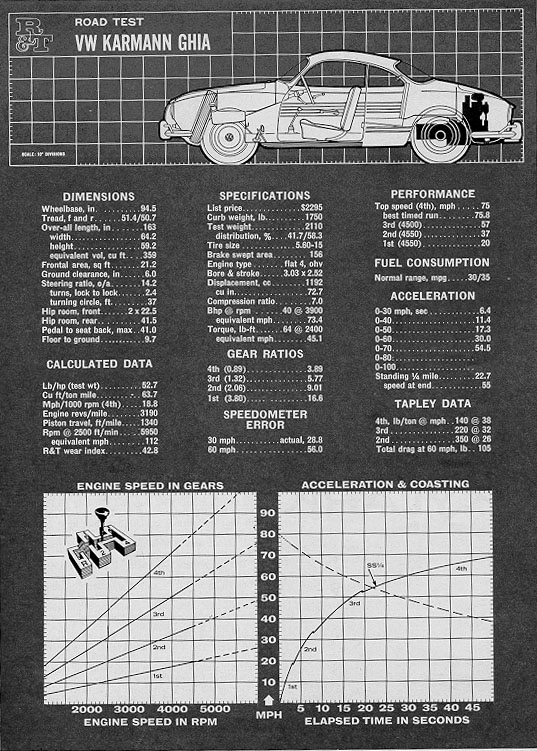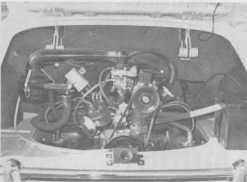March 1962 edition of Road & Track - The Motor Enthusiasts' Magazine, Vol. 13, No. 7

|
KARMANN GHIA VW A sleeker wagen fur fewer (und richer) volks
|
 CARS
MAY COME AND CARS MAY GO, but the Volkswagen goes on forever or
so it seems. And the rich cousin to the lowly people's car, the
Ghia-designed, Karmann-built coupe and convertible seems also
to go on forever. CARS
MAY COME AND CARS MAY GO, but the Volkswagen goes on forever or
so it seems. And the rich cousin to the lowly people's car, the
Ghia-designed, Karmann-built coupe and convertible seems also
to go on forever.Road & Track conducted its first road test of a Karmann-Ghia Volkswagen in April 1956, shortly after its introduction, and said "This coupe is actually available for purchase, providing the customer is well supplied with patience. The statement is still valid today, although the wait is not quite as long as it was in 1956. We, too, have been waiting, not to buy one but to test a newer model, never expecting that, like the sedan, it would be continued (seemingly forever) with little or no change. There is, of course, a Karmann version of the VW-1500, which we will get to later, but this test car is merely a refined version of the one tested six years ago. Since the Karmann-Ghia's introduction it has almost seemed an orphan, due to the lack of effort put into advertising or promoting it, even though sold and serviced by all VW agencies. It is, in essence, a standard Volkswagen with more attractive bodywork (for approximately $700 dollars extra). Few changes have been made other than the usual and expected refinements that were also added to the sedan. In fact, every change and/or improvement made to the sedan has been incorporated into the K-G (wherever applicable) at the same time. Most important was the change in 1960 from 36 to 40 bhp, a seemingly insignificant amount when viewed as only a four horsepower gain, but it represents an 11% increase, which made the |
|
difference between barely adequate performance
and that which is very satisfactory. The addition of a fuel gauge in the 1962 models was a move that was long overdue in the minds of many Volkswagen owners, and yet we've talked to some who still prefer the old tried and true reserve tank with manual control switch. And then there are those who would like both9but some people are never satisfied. The seating in the K-G is considerably more comfortable and sporting than it is in the sedan, but entrance and exit are more difficult due to the low build of the car Headroom is also more limited because of the body syling, but this is the price one pays for the better appearance; a price apparently thought to be well worthwhile by more than 9000 K-G buyers (new cars only) in 1961. There is no shortage of foot room because of the great amount of seat adjustment The ITe front wheel wells encroach into the passenger area , causing the pedals to be mounted slightly offset to the right. This puts the new driver off a bit, but he soon gets used to it. Other than the obviously different seating position the Karmann-Ghia drives and handles like its production counterpart, Just as you'd expect. All the familiar Volkswagen noises, peculiarities and attributes arc there, and in about the same amount For some unexplainable reason one feels as though the coupe is performing much better than the sedan In top speed it does9due to the lower frontal area and better shape. Acceleration, though, is slightly better on the sedan because of a weight penalty of about 70 lb for the |
coupe. The cross-over point on the two cars'
acceleration curves is at very nearly the top speed of the sedan.
As with any make of car, exceptions can always be found and there
will occasionally be a Volkswagen sedan that will run rings
around a coupe. but it isn't normal. The lower frontal area and subsequent higher top speed pay off in another way too9the ability to maintain a higher cruising speed. Because of the engine design and factory selected gear ratios the cruising speed of a Volkswagen is the same as its top speed. This then, automatically gives the coupe about 8 mph advantage over the sedan for sustained and reliable cruising. We've heard many times about how the K-g coupe will be less disturbed (than the sedan ) by cross winds because of its lower silhouette. We're not convinced We drove the coupe in a hard, gusty off-shore wind along the ('CAlifornia coast and couldn't detect any great difference between the two, if there was any. It would seem that the coupe should be less affected in a wind because of the lower profile (and less mass) presented to the wind, but a car's handling characteristics in a cross wind are determined, to a great extent, by the relation of the center of gravity to the center of pressure: i.e. if the c.g.. is forward of the c.p.., then the car will be [theoretically] stable. If the c.g.. is aft of the c.p.. then the car will be [relatively] unstable. The rearward weight bias of the coupe (58.3%) is greater than the sedan's 57% and this, coupled with the coupe's c.p.. being farther forward, reduces the advantage of the smaller total area. The adverse effect of cross winds (which incidentally |

| KARMANN GHIA continued | |

|
apply to most tail-heavy cars) is the only strong
criticism we have of the Karmann-Ghia coupe's handling. In any
other situation the car is very pleasant to drive. In expressway driving there is very little to choose between one car and another9they all seem good9but when the going gets rough, cars with independent 4-wheel suspension show a marked superiority over their competitors. The K-G is no exception and takes freeways, ruts bumps and potholes with equal aplomb and little pitching as long as the dampers are good. The pitching action that does exist is almost identical to that of the parent Volkswagen but is not as noticeable because the driver sits closer to the pitch axis than he would in the sedan, where pitching movement is amplified. In designing the Volkswagen, Dr. Ing. Ferdinand Porsche utilized a front and rear suspension arrangement not too much different from that of the famous AutoUnion racing cars which came from his drawing boards and which also were powered by rear-mounted engines. All current Volkswagens retain the swing axle rear end (some sort of independent suspension is necessary with a rear-mounted engine ) and parallel trailing arm front suspension that has been a design feature of the Volkswagen since the first model. Transverse torsion bar springs are used all around, laminated square in front round at the rear, with tubular hydraulic shock dampers. As with all cars carrying a majority of the total vehicle weight on the rear wheels, there is a tendency to oversteer 9the degree of oversteer being determined to a great extent by the type of suspension employed. To help counteract the oversteering characteristics, a problem so serious on the racing cars that few drivers could ever make full use of the brutish 600 bhp available, Dr. Porsche designed a front suspension with the roll center at ground level, which contributes to an understeer condition. This minimizes, but does not completely negate, the oversteer caused by the rear end weight bias. Casting all theory and speculation aside, the Karmann Ghia is still a Volkswagen, with all that the phrase implies. It will carry two people, and their luggage, in reasonable comfort at a reasonable speed, and with economy and reliability. Not much more could be asked of it. |



